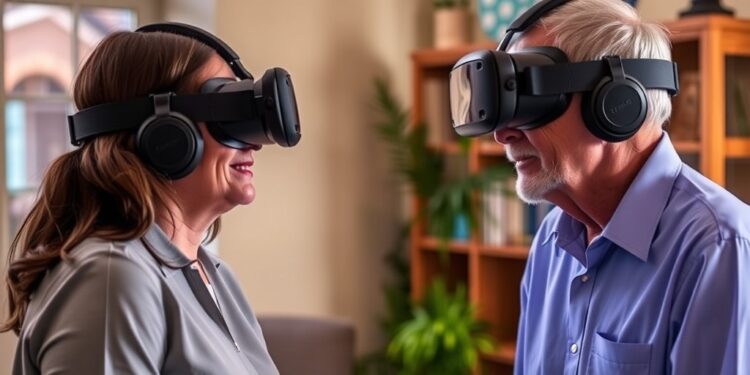Virtual reality (VR) technology, traditionally associated with gaming and entertainment, is now emerging as a groundbreaking tool in the early detection and research of Alzheimer’s disease. Recent findings reveal how immersive VR environments can offer novel, non-invasive ways to assess cognitive decline, providing significant implications for early diagnosis and intervention strategies. This shift represents a remarkable convergence of technological innovation and medical research, particularly in the realm of cognitive neuroscience, aiming to better understand memory and navigation, two critical areas of focus in dementia studies.
The growing field of cognitive neuroscience has increasingly embraced VR technology as a means to explore the subtle cognitive changes that precede the clinical onset of Alzheimer’s disease. Through VR, researchers can craft highly detailed, three-dimensional environments that facilitate testing memory and spatial navigation in a way that traditional two-dimensional assessments cannot match. The immersive experience allows participants to interact with their surroundings in a manner reminiscent of real-life scenarios, thereby improving researchers’ capability to evaluate cognitive functions.
Early detection remains paramount in the fight against Alzheimer’s disease, given its impact on patients’ quality of life. Traditional diagnostic methods often rely on cumbersome and invasive procedures, such as biomarker collection from cerebral spinal fluid. The advent of VR offers a less invasive approach, enabling clinicians to assess memory function through behavioral evaluations that rely on participants’ ability to navigate immersive environments and remember object locations within those settings. This innovative methodology not only provides an engaging experience for participants but also fosters a deeper understanding of how memory works in healthy individuals compared to those at risk of cognitive decline.
Research presentations at the annual Cognitive Neuroscience Society meeting highlight the significant advances achieved in linking VR assessments to biological markers associated with Alzheimer’s disease. Recent studies conducted by teams at prestigious institutions such as Stanford University and the University of British Columbia emphasize the importance of combining these technological assessments with biofluid biomarkers. By correlating cognitive performance in VR tasks with specific proteins known to be involved in Alzheimer’s pathology, researchers have made strides in predicting an individual’s risk for developing the disease.
One of the more compelling aspects of this research is its focus on spatial memory and navigation, critical areas impacted early in cognitive decline. For instance, studies have suggested a clear discrepancy between the navigational abilities of younger and older adults, as well as between those diagnosed with mild cognitive impairment and healthy older individuals. Researchers have uncovered that the presence of specific Alzheimer’s-related proteins, such as pTau217, can significantly affect performance in tasks requiring spatial memory, indicating that these biomarkers could serve as reliable indicators of cognitive health.
Furthermore, researchers are exploring various complexity levels within virtual environments to better understand how cognitive strategies change with age and illness. Early findings suggest that as the complexity of a VR navigation task increases, so too do the differences in performance across age groups and health statuses, shining a light on the potential for tailored assessments that account for individual capabilities. The implications for clinical practice are vast, as this knowledge could lead to the development of specific memory assessment tools targeted at older adults, especially those at risk for dementia.
Healthcare professionals and researchers alike are expressing excitement at the possibilities offered by VR technology. By drawing parallels between the way VR systems function and the human cognitive process, researchers can measure subtle variations in cognitive performance linked to early Alzheimer’s pathology. This approach not only enhances the rigor of cognitive assessments but also provides engaging interactions that can reduce participant anxiety, making them more comfortable and receptive to the research process.
The significance of recent findings in VR technology and Alzheimer’s research cannot be overstated. Studies suggest that this novel use of technology might redefine early diagnostic practices, moving away from traditional methods towards a more nuanced understanding of psychological and neurological health. The shift toward non-invasive assessments, bolstered by advancements in VR, presents a promising frontier that may ultimately lead to more effective strategies for managing and treating Alzheimer’s disease.
Moreover, this evolution in assessing cognitive decline could pave the way for broader applications beyond Alzheimer’s research. Understanding how VR can serve as a diagnostic tool opens the door for its application in exploring various cognitive disorders and age-related declines. The potential for influencing how we engage with cognitive neuroscience is profound; there lies an opportunity for extensive exploration of cognitive processes in ways that were previously unimaginable.
As the field continues to expand and evolve, researchers hope that the accessibility and affordability of VR technology will inspire collaborations across disciplines, bringing together experts from engineering, robotics, and neurosciences to address pressing cognitive questions. This multidisciplinary approach not only advances our understanding of dementia but also fosters an environment of innovation where new ideas and technologies can flourish.
In summary, the integration of virtual reality into cognitive assessments offers an exciting glimpse into the future of Alzheimer’s research and diagnostics. Through immersive experiences that replicate real-world interactions, researchers are uncovering critical insights into memory and spatial navigation, contributing to early detection and intervention strategies tailored for at-risk individuals. As this field continues to grow, the potential for VR technology to transform cognitive neuroscience and improve patient outcomes remains extraordinarily promising.
Subject of Research: Virtual Reality in Alzheimer’s Disease Detection
Article Title: Innovative Advances in Alzheimer’s Detection Through Virtual Reality
News Publication Date: April 1, 2025
Web References: Cognitive Neuroscience Society
References: National Institute on Aging, Oliver Sacks’ The Man Who Mistook His Wife for a Hat
Image Credits: Cognitive Neuroscience Society
Keywords
Virtual Reality, Alzheimer’s Disease, Cognitive Neuroscience, Early Detection, Spatial Memory, Biomarkers




